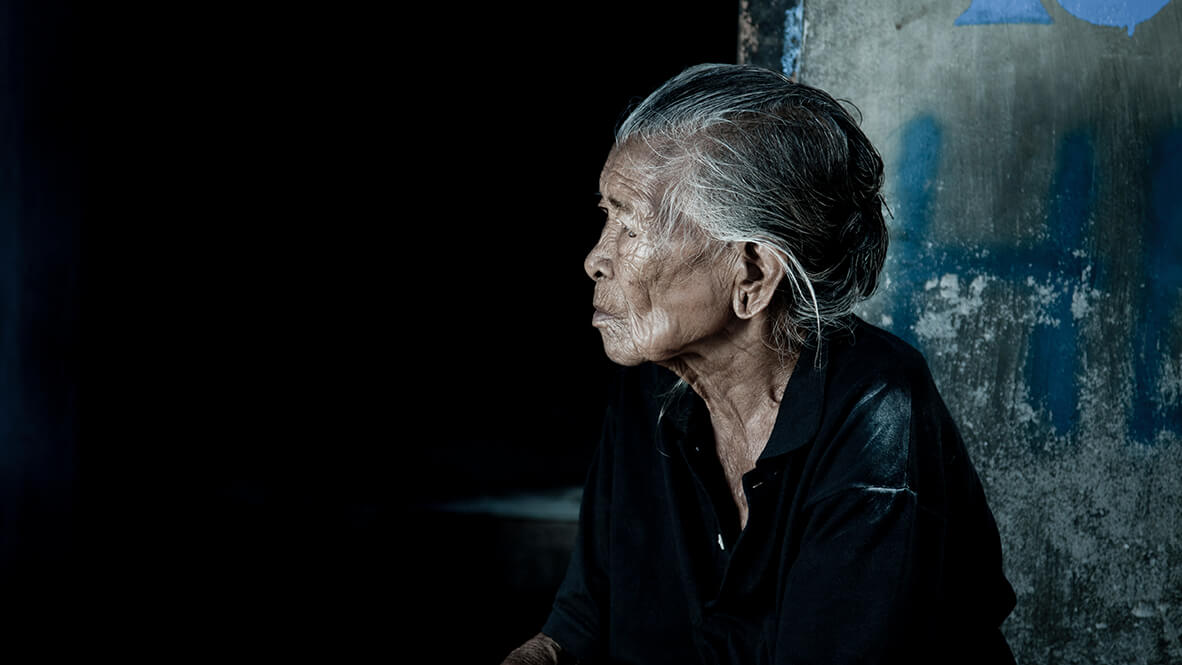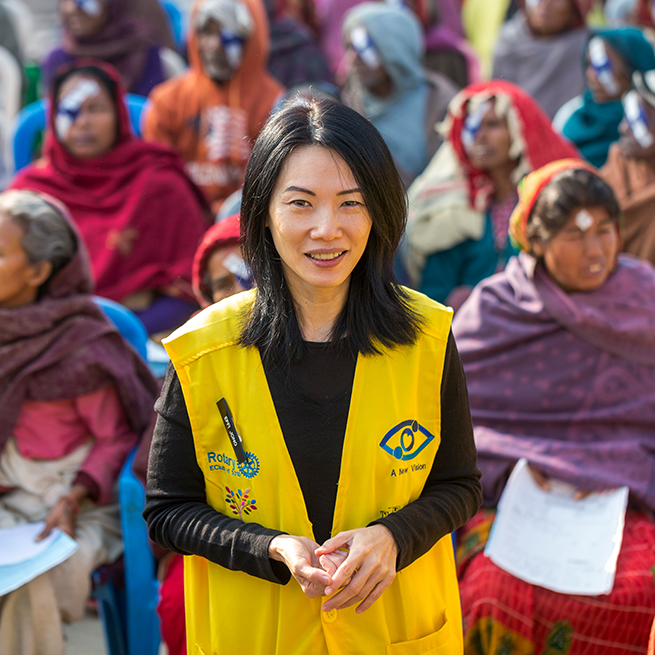An estimated 253 million people in the world live with vision impairment – and of those, 36 million are blind and 217 million have moderate to severe vision impairment. These staggering statistics from WHO Vision Impairment and Blindness Fact Sheet (dated October 2017) also show that over 80% of all vision impairment can be prevented or cured.
Uncorrected refractive errors and unoperated cataracts are the top two causes of vision impairment. Twenty million people are blinded by cataract, which remains the leading cause of blindness in low- and middle-income countries. This is because many visually impaired patients cannot afford treatment, have no access to good eye care, do not know that their blindness is curable or that a one-off surgery can restore vision.
If a person with visual impairment loses the ability to earn a living (which happens often), they can become a burden on other family members. In addition, blind people often feel neglected and this often leads to depression and other mental illnesses.
In recognition of the prevalence and burden of vision impairment, a non-profit organization was formed to make eye care accessible to all, regardless of patients’ ability to pay. Based in Singapore, A New Vision (ANV) has been actively funding and coordinating free clinics, providing free cataract surgeries to the masses. These clinics, predominantly in Indonesia, have been running on a regular basis and restore sight to thousands of people annually. ANV’s aim is to eliminate cataract induced, curable blindness throughout the world.
Advancements in medical technology have enabled cataract patients to see again following a 5-10-minute, low-cost surgery. With proper postoperative care, patients can regain their sight within 48 hours or less.
Co-founder Effi Jono witnessed the awe-inspiring event of restoring vision to 695 people (some had lived with blindness for 30 years) and realized the massive impact these surgeries have. The organization had its humble beginnings in 2010, with four individuals pooling funds raised from family and friends for its first free cataract clinic in Indonesia.
Ms. Jono, who is originally from Indonesia and spent most of her working life in the corporate world, met Singaporean Tan Ching Khoon who shared her desire to help the less fortunate. They hoped to start a humanitarian project with well-known humanitarian eye surgeon Dr. Sanduk Ruit, whose Tilganga Institute of Ophthalmology in Nepal is a place where the poor are treated equally and can afford superior eye care.
With the help and connection of her uncle Dr. Indra Wahidin, a prominent social activist in Indonesia (North Sumatra, specifically), Ms. Jono decided to approach Dr. Ruit to provide medical help to the visually impaired in Indonesia.
“I travelled to Kathmandu to meet Dr. Ruit and within five minutes of our meeting, he said, `if you think you can bring us to Indonesia, we are ready’,” recalled Ms. Jono. “Unbeknownst to me, the international ophthalmology community there was well aware of the high prevalence of blindness in Indonesia but faced difficulty and resistance from Indonesian counterparts to assist.”
In the first week of December 2010, Dr. Ruit and his team arrived in Indonesia and performed 600 surgeries in a few days.
“It was the first time I saw so many blind people at one spot. Some had been blind for decades and they could see the very next day after the surgery. It was unfathomable that they had been living in misery all these years when a simple procedure could have cured them,” shared Ms. Jono.
Spurred by what they witnessed, Ms. Jono, Dr. Wahidin and Tan Ching Khoon decided they must not let this fire die, and together with Dr. Ruit, they formed A New Vision (ANV) to continue the work of treating the visually impaired.
“We did not have any organizational name when we did our first event, and all of the funds required were contributions from family and friends. Fortunately, as we grew, we managed to attract many good volunteers. They have been very helpful in helping us with many logistical tasks – from booking flights and payment processing to website maintenance and newsletters.”
ANV works with local communities and relies on local community figures to bring patients to their events. The responses from patients have always been very good. Their partners include local community groups, local government and international blindness foundations like the Fred Hollows Foundation and Tilganga Institute of Ophthalmology, corporate donors, individual donors and volunteers.
“We focus on helping to alleviate blindness, specifically cataracts as 50% of blindness in developing countries is caused by cataract. Here, cataract are formed 10-15 years earlier due to higher exposure to UV rays and are often found in those with outdoor occupations such as farmers, fishermen and plantation workers,” said Ms. Jono.
They also provide basic education on eye health to local communities and support Indonesian surgeons and eye nurses for training at Tilganga Institute of Ophthalmology.
According to ANV’s website, through their events in various communities in Indonesia, ANV has checked close to 57,000 people for eye diseases and performed close to 21,500 successful sight restoration surgeries. In addition, 9,178 community representatives have been trained in basic eye health education.
Ms. Jono noted that ANV still faces many challenges today, including protests from certain people and groups: “Some ophthalmologists believe these patients are their inventories, and that by giving these free surgeries, we are taking their potential income away. Other ophthalmologists prefer that we pay them at a rate they set to do the surgeries at their convenience.”
There have been other problems too, like donors who promised donation or sponsorship and parties who were supposed to play their part, then did not honor their commitment and could no longer be contacted after the event.
Running ANV can be a roller coaster ride. However for Ms. Jono, it’s all worthwhile when she sees patients who have regained their sight. “Many of these people already suffer so much in life, and on top of that, they are blind. When it only takes minutes of treatment to return their sight, not doing anything to help them is a crime,” she explained.
ANV is striving to take bigger and bolder steps. In 2017, it began performing cataract surgical outreach in countries outside Indonesia, namely Cambodia and Nepal. ANV is now a member of The International Agency for the Prevention of Blindness, with an objective to eliminate avoidable blindness by the year 2020.
“Our goal is to replicate the sustainable Community Eye Hospital, where Dr. Ruit was successful in reducing the rate of blindness in Nepal, particularly in communities where there is evidence of higher need,” said Ms. Jono.
She hopes that ANV can be more sustainable – that they can have a steady income stream to carry on the work and inspire more people, groups and organizations to collaborate with them.
“We also hope that government authorities realize that although blindness is not a deadly disease, it significantly reduces one’s quality of life and causes burden and hardship to the family. We hope the government will take action to place blindness eradication high on public health agenda,” she concluded.
Testimonies of Hope
ANV’s newsletters highlight success stories of individuals whose eyesight has been restored from surgeries at their cataract clinics over the years. The newsletters are a heartwarming read and are published once or twice annually. Past issues can be found on ANV’s website (www.anewvision.org) and serve as a form of communication for the organization’s supporters and donors, with the purpose of spreading awareness about what they do and their needs.
The first few years of ANV newsletters were compiled in a Word document by Ms. Jono herself. Later, she received editing and graphic design help from some committed volunteers.
In 2014, the newsletter was named “New Sight,” and now contains more colors and pages to accompany the touching testimonies and other useful information on eyesight and ophthalmology.
Excerpts from ANV newsletters
A Homeless Lady Gets Hope in Sight (2016/2017)
This inspiring woman, Tan Swie Lan who is in her 70s, heard about our cataract surgical event in Central Java over the radio. Homeless and taking shelter at her neighbor’s house, Mrs. Tan has no other family members.
With her vision limited to just shadows (hand movement), Mrs. Tan’s resolve to see again was so great that she took a bus to our screening place all alone and arrived stumbling at the front gate. Guide dogs, white canes and other devices for the vision impaired that we in the developed world take for granted are simply unattainable for the very poor in countries like Indonesia. Their lives are far more drastically impacted by their vision loss due to the lack of visual aids combined with a rudimentary lifestyle. Although she has no material possessions to speak of, Mrs. Tan is a woman of immense dignity. At lunch, as we did for all of our patients, we brought her a lunchbox of rice. Ten minutes later she said, reaching into her pocket to retrieve a few old crumpled notes, “Someone gave me a packet of rice. I haven’t paid for the rice yet, how much do I owe?”
Everyone at the event was charmed by this inspiring and very kind lady. She made friends at the outreach and although she arrived alone and blind, she went home with both new sight and new friends – many of whom live in the same village as her.
Lelihai and her Mother (June 2016)
Meet 32 year-old Lelihai, who, as a child, was blinded in her right eye by a rock from boys playing slingshot. Imagine the devastation when she found her only functioning eye became blind from cataracts. Her husband divorced her. She had to give her 6-year-old daughter to her sister because she could no longer look after her. She subsequently moved back to live with her mother in a remote village where the two earned a living selling wood collected from a nearby forest. Their average daily income was just US 38 cents.
Working together, the two would collect wood. Dewi, Lelihai’s 62-year old mother, would find and pick up the wood. She would then hand it to the younger Lelihai to carry. With their futures uncertain except for the likelihood of poverty, anxiety was high. But both women’s lives have been transformed by recent surgery curing the cataract in Lelihai’s left eye, their job prospects and earning potential vastly improved.




